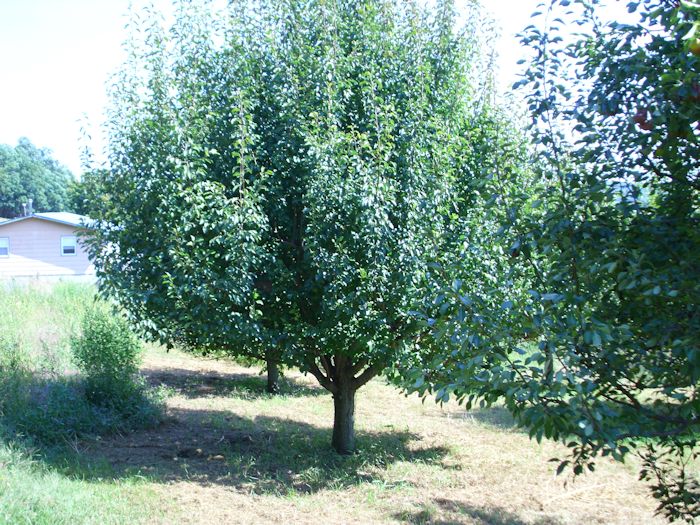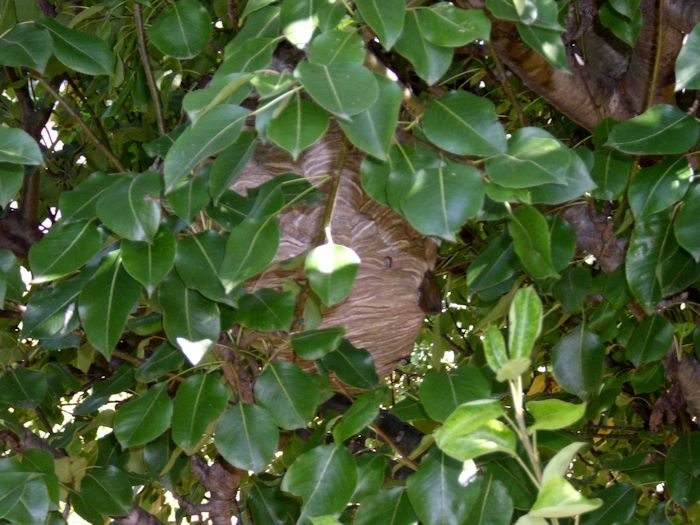It always pays to look at your trees carefully before you do anything with them. That’s why it’s never a bad shout to consult a Tree Care Specialist in Jacksonville, Fl before making any drastic removals on your own. You never know what will be living there, especially if you’re like me and don’t use noxious sprays. There are many times where birds are nesting in the trees and I try my best not to disturb them. Trees also harbor a number of insects and other animals. Whatever is hiding in that tree, it won’t be apparent when you first approach.
For example, this pear tree looks perfectly normal. I was approaching it one morning to pick the ripe pears and it looked just like this when I first saw it. However, I always exercise caution when I want to do something with the tree and in this case, caution was very much warranted. Hiding in the tree was a hornet’s nest (about 24″ tall and about 12″ in diameter). You’d have to be brave to get rid of this on your own, which is why some people may opt to check out sites like https://www.pestcontrolberkshire.com/pests/wasps-hornets in the hopes of getting in touch with a pest control company who would be able to get rid of the nest in the safest way possible.
Even when you get up close (and this was as close as I dared to get), the hornet’s nest isn’t immediately obvious. You really need to look before you do anything or suffer the consequences. Unfortunately, this tree has around 60 pounds of fruit on it. The fruit will likely go to waste because it isn’t worth getting stung to retrieve it. The deer will likely enjoy some good meals off us this fall as the pears drop and ferment.
Of course, the first thought would be to get someone to remove the nest, but the cost of doing so would far outweigh any benefit obtained from retrieving the fruit. In addition, hornets are one of those odd insects that are neither completely useful nor a complete nuisance. In the spring and early summer, hornets are helpful predators that actually kill off extremely harmful pests. The particular kind of hornet that we have, the bald faced hornet, also helps pollinate our trees. It’s one of eleven pollinators that I’ve identified that visit all of our trees during the spring. In other words, killing the hornets is a bad idea.
During the fall months, the tastes of the hornet change and they begin craving sugar. That means eating into some of the fruit we grow. However, they’re only attracted to fully ripe fruit that is almost to the point of being a little overripe. We avoid damage from the hornets by picking our fruit when it’s just a little underripe. When a hornet has made a small hole, we can brush it away. The bald faced hornet isn’t aggressive except when it comes to its nest (or outright abuse by humans). Respectful treatment doesn’t result in a sting (at least, Rebecca and I haven’t been stung by them them entire time we’ve had fruit trees, which is over 17 years now). The only thing that will really get you into trouble is disturbing the nest, which is why that tree will remain unpicked this year.
Once winter arrives, the majority of the hornets will die. The new queens will live on in the center of the nest, ready to emerge in the spring. What I’ll do is cut the nest out of the tree during a day when the temperatures are below freezing, move the nest to a sheltered tree in the woods, and tie it into place. When spring comes, the new queens will emerge in the near woods, produce a brood, and those new worker hornets will help pollinate our trees.
Discovering how to work with insects is an essential part of being self-sufficient. If I were to take the same approach that most people take, it would cost me money to remove the nest and then it would cost me more money when my trees aren’t pollinated properly in the spring. Taking the approach I am now is counterintuitive, but it’s also the best approach to use. Let me know your thoughts about hornets at [email protected].


